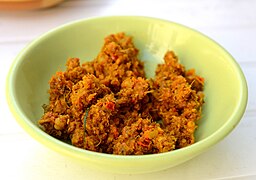タイカレー
Thai curry/ja
| Thai curry/ja | |
|---|---|
 ローストダックのレッドカレー、ゲーン・ペッ・ペッ・ヤーンの器 | |
| 種類 | カレー |
| 発祥地 | タイ |
| 主な材料 | |
タイカレー(Thai: แกง, romanized: kaeng、th)は、タイ料理の1つで、カレーペースト、ココナッツミルクまたは水、肉、魚介類、野菜または果物、ハーブから作られる料理である。タイのカレーは、インド亜大陸のカレーとは、主に乾燥スパイスの混合物ではなく、新鮮な根茎、ハーブ、香り高い葉などの材料を使う点で異なる。
定義

1873年(西暦、タイ仏暦2416年)の最初のタイの辞書では、「ゲーン」を米と一緒に食べる水気のある料理で、シュリンプペースト、タマネギまたはエシャロット、チリ、ニンニクを必須の材料として使用すると定義している。この定義にはココナッツミルクは含まれておらず、ゲーンソムやゲーンパーなど、多くのタイカレーにはココナッツミルクが含まれていない。ラーンナー(タイ北部)料理のカレーは、ごく一部の例外を除いて、タイ高地の気候ではココナッツの木があまり育たないため、ココナッツミルクを使用しない。タイカレーの辛さは、ペーストの製造に使用されるチリの量と種類によって異なる。同じ種類のカレーでも、辛さは大きく異なる場合がある。
タイ語では「カレー」という言葉は「kari」(Thai: กะหรี่)として登場し、タイではphong kariとして知られるインド風のカレー粉を使用する料理、またはゲーンカリーと呼ばれる料理を指す。これは、インド料理に共通するスパイスを使用するが、タイ料理ではあまりこの割合で使用されないインド風のカレーである。Kung phat phong kari(エビと卵とカレー粉の炒め物)は、インド料理風のカレー粉を使用した料理の一例である。
"ゲーン"は「水気のある」物質であると定義されているが、ソースの濃度は出汁のようなものから濃厚なシチューのようなものまでかなり異なり、完全に乾いた料理の場合もある。カレーペーストで(炒め)調理された乾いたカレーの代表的なものには、パットプリックキンやクアクリンがある。ゲーンソムとゲーンパーは、より出汁に近いカレーの代表である。マッサマンとゲーンクアはシチューに似ている。ホーモックプラー(蒸しカレー)、ゲーンクラダン(タイ北部のカレーアスピック)、カノムチンナムギアオなどの麺料理も、すべてカレーペーストを使用して調理されるため、タイカレー料理と見なされている。
ゲーンチュートと呼ばれる料理は、ゲーンがチリ、ニンニク、タマネギ、シュリンプペーストを含むべきであるという規則の例外である。これは、中華風の透明な肉や野菜の出汁で、野菜の盛り合わせと、しばしば豚ひき肉、豆腐、春雨も含まれる。その名前は"bland curry"と訳されるが、tom、つまりスープと見なされており、そのためtom chuetとも呼ばれることが多い。
カレーは米と一緒に食べられ、中部とタイ南部では長粒のジャスミンライスが、北部と東北部ではもち米が、またカノムチン(発酵米麺)などの麺類とも食べられる。一部のカレーは、マレーシアのインド風の揚げ平たいパンであるロティチャナイのタイ版であるrotiとも食べられる。
カオゲーンまたはkhao rat kaengは、「カレーライス」を意味し、作り置きのカレー、そしてしばしば他のいくつかの料理も米と一緒に提供する、タイの伝統的なファーストフードレストランの一種である。バンコクでは、手軽な昼食の場所としての人気は低下している。
典型的な材料

カレーペースト


タイカレーは常にカレーペーストで作られる。多くのタイカレーペーストに使われる一般的な材料は以下の通りである。
Depending on the type of curry, additional ingredients for the paste can include spices such as turmeric, pepper, coriander seeds, cardamom pods, and cumin, or other ingredients such as boiled fermented fish, and fingerroot. Ingredients are traditionally ground together with a mortar and pestle, though increasingly with an electric food processor. With many curries, the paste is first stir-fried in cooking oil before other components are added in to the dish. This allows certain flavours in the spices and other ingredients in the paste to develop that cannot be released at the lower temperature of boiling water.
Both khrueang kaeng (lit. 'kaeng ingredients') and nam phrik kaeng (lit. 'kaeng chilli paste') are used to describe "curry paste" in Thailand. The latter is sometimes even shortened to only phrik kaeng (lit. 'kaeng chilli').
Thai curry pastes can be made at home from the bare ingredients, bought freshly made at markets in Thailand, or they can be had packaged at shops and supermarkets.
Main ingredients
Most Thai curries are made with meat, fish or shellfish as their main ingredient. Vegetables and fruit, but also certain tree leaves such as from the Acacia pennata (cha-om) and the Ficus virens (phak lueat), and flowers such as those of the Sesbania grandiflora (dok khae) and banana (hua pli), can be added. Curries that contain mainly vegetables are, for example, kaeng liang (mixed vegetables) and kaeng nomai (bamboo shoots). Ingredients were dictated by regional and seasonal availability: both pork and chicken (possibly first domesticated from wild jungle fowl in what is now Thailand) are easily available, and so are many varieties of fish, and shellfish, both fresh water species from the many rivers, lakes and rice paddies, as well as salt water species from the Andaman Sea and the Gulf of Thailand. Other traditional ingredients in Thai curries include frogs, snakes, snails, wild birds and game such as Sambar deer and wild boar. Commonly used vegetables in curries are Thai eggplant (makhuea pro), yardlong beans (thua fak yao), and different types of squash and pumpkins (fak).
Additional ingredients
Fresh kaffir lime leaves (bai makrut), fingerroot (krachai), or fresh herbs such as Thai basil (horapa) are often added to Thai curries. Kaffir lime leaves and krachai are often cooked along with the other ingredients but fresh herbs such as Thai basil are nearly always added at the last moment to preserve the full taste and serve as a contrasting note to the flavours of a curry. Fish sauce is not only used when cooking the curry as a flavouring and for its salty taste, but it is usually also available at the table as a condiment, mixed together with sliced green bird's-eye chillies for those that prefer their curries more salty and spicy.Sugar (traditionally palm sugar) is used with curries that need to be sweetened. Besides lime juice, tamarind juice can also see use in sour curries as the souring agent such as in kaeng som. To achieve the most fragrance from the ingredients in a curry paste, the curry paste is often first fried together with vegetable oil or coconut oil that has separated from the coconut cream, before adding in the other ingredients.
Popular Thai curries

- Kaeng kari (lit. '"curry" curry', it is known as "yellow curry" in the West)
- Kaeng khae, a curry of northern Thai cuisine
- Kaeng khiao wan (lit. 'green sweet curry', it is known as "green curry" in the West)
- Kaeng pa (lit. 'jungle curry', in addition to the curry paste, it uses whatever is available in nature)
- Kaeng phet (lit. 'spicy curry', it is known as "red curry" in the West)
- Kaeng som (lit. 'orange curry', every region has its own variety)
- Kaeng matsaman (lit. 'Muslim curry'; the name matsaman is supposedly derived from "mosalman", an archaic word for "Muslim")
- Kaeng ranjuan (a leftover food with spicy, sour, sweet, and salty beef curry seasoned with no more than fermented shrimp paste chili sauce)
- Khao soi (a Burmese-influenced curry noodle soup from northern Thailand)
- Phanaeng (the name possibly refers to the Malaysian island state of Penang; this is a creamy and generally mild curry)
- Phat phrik khing (lit. 'stir-fried chilli ginger', this Thai curry actually does not contain ginger)
Gallery
-
Phanaeng paste is fried together with coconut cream
-
Kaeng phak lueat, a northern Thai curry with ficus leaves
-
Ho mok pla, steamed fish curry
-
Khua kling, an extremely spicy, dry fried curry from southern Thailand
-
Khao soi, a curry noodle soup from northern Thailand
-
Kaeng kradang, a pork curry aspic
-
Kaeng chuet, the curry that isn't curry, but actually a soup.
-
Kaeng tai pla, made from fermented fish entrails
-
A seafood curry in the United States inspired by the flavors of Thai cuisine
-
Kaeng hang le, a northern Thai curry with Burmese influences
関連項目
参考資料
外部リンク
![]() Media related to Thai curry at Wikimedia Commons
Media related to Thai curry at Wikimedia Commons
| この記事は、クリエイティブ・コモンズ・表示・継承ライセンス3.0のもとで公表されたウィキペディアの項目Thai curry(4 May 2025, at 22:13編集記事参照)を翻訳して二次利用しています。 |









